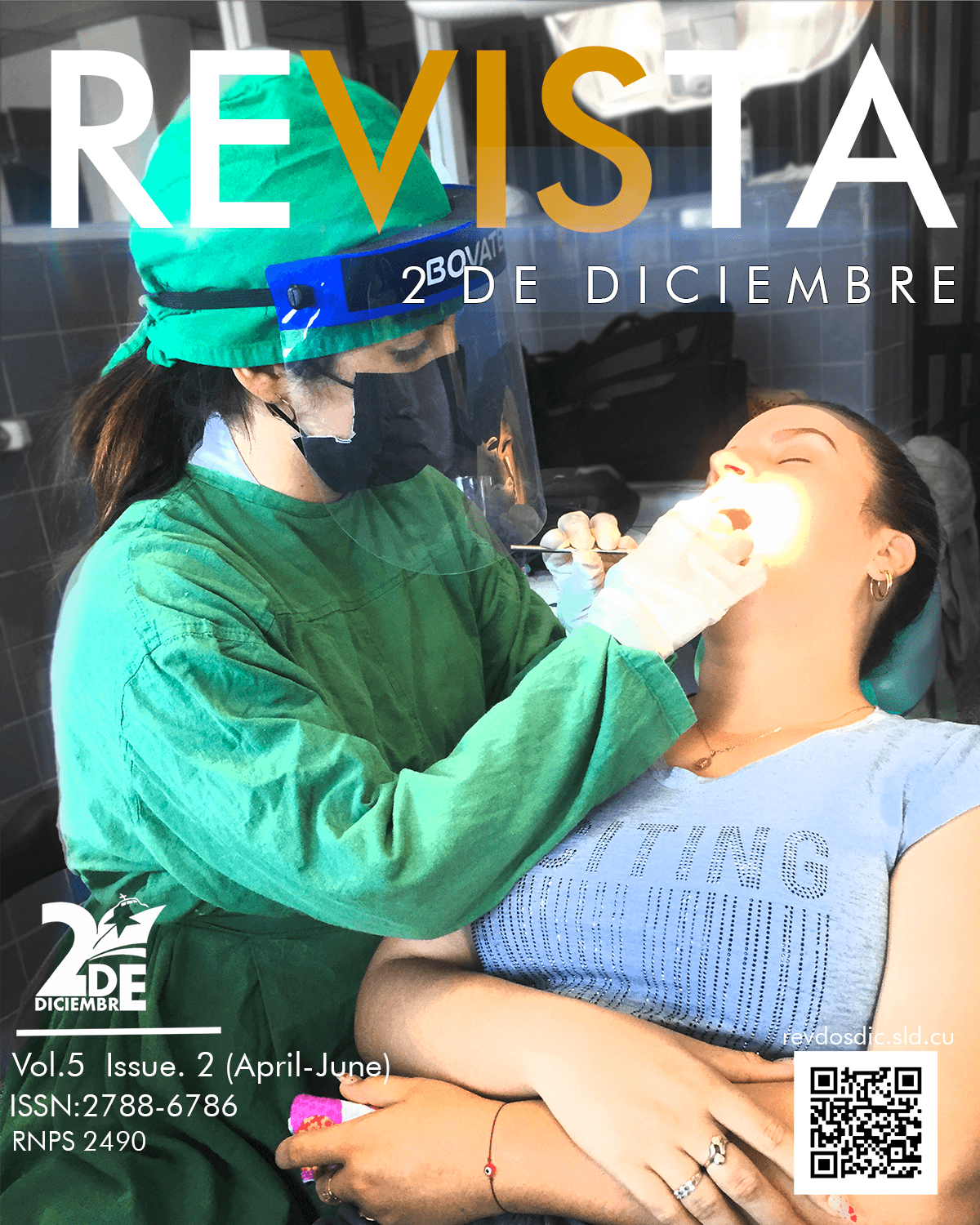Twin blocks appliances treatment in patients with Moyers class III syndrome
Keywords:
Twin block, Orthodontic appliances functional, Prognathism, Retrognathia, Temporomandibular joint, Dental occlusion.Abstract
Introduction: Moyers class III syndrome is characterized by discrepancy in arch length, skeletal problems, muscle dysfunction, dental problems, and the patient's facial profile. In the national and international literature there is no evidence of the efficacy of treatment with twin blocks of Moyers class III syndrome.Objective: to evaluate treatment with twin blocks in patients with Moyers class III syndrome.Method: a quasi-experimental intervention study was carried out before and after without a control group, at the Manuel Cedeño University Clinic of Stomatological Specialties, in the period from January 2018 to March 2021. The sample was 93 patients. The variables studied were the occlusion relationship, the skull-mandibular skeletal relationship and the temporomandibular joint dysfunction. Class III twin blocks were placed in all patients.Results: with the use of twin blocks, significant changes were obtained in the molar ratio (-7,030 ± 0,7287 mm) and the overhang (2,213 ± 1,6074 mm); the skull-mandibular skeletal relationship was improved (2,659° ± 1,8696°); the function of the temporomandibular joint was found to be without symptoms and mild in 64,86 % and 57,14 % respectively, after treatment.Conclusions: with the use of twin blocks, the relationship between dental occlusion and cranio-mandibular skeletal class III is corrected, in addition to being an orthopedic-functional option that improves temporomandibular joint dysfunction in patients with Moyers class III syndrome.Downloads
References
1. Li C, Cai Y, Chen S, Chen F. Classification and characterization of class III malocclusion in Chinese individuals. Head & Face Medicine [Internet]. 2016 [citado 13 May 2021]; 12(31). Disponible en: https://link.springer.com/article/10.1186/s13005-016-0127-8
2. Morales Fernández M. Bases genéticas de la maloclusión clase III esquelética. [Tesis Doctoral Inédita]. Universidad de Sevilla. 2017. Disponible en: https://idus.us.es/handle/11441/74326
3. Clemente R, Contardo L, Greco C, Di Lenarda R, Perinetti G. Class III Treatment with Skeletal and Dental Anchorage: A Review of Comparative Effects. BioMed research international [Internet]. 2018 [citado 13 May 2021]. 7946019. https://www.ncbi.nlm.nih.gov/pmc/articles/PMC6051274/
4. Minase RA, Bhad WA, Doshi UH. Effectiveness of reverse twin block with lip pads-RME and face mask with RME in the early treatment of class III malocclusion. Progress in Orthodontics [Internet]. 2019 [citado 13 May 2021]; 20(14). Disponible en: https://www.ncbi.nlm.nih.gov/pmc/articles/PMC6451935/
5. Ji LL, Sun DX, Shi LB, Kyung HM, Bing L, et al. Cambios Morfológicos del Regulador funcional Frankel III en dentición mixta con maloclusión clase III. Int. J. Morphol. [Internet]. 2020 [citado 13 May 2021]; 38(4): 1053-1059. Disponible en: http://www.scielo.cl/scielo.php?script=sci_arttext&pid=S0717-95022020000401053&lng=es. http://dx.doi.org/10.4067/S0717-95022020000401053.
6. Ni J, Song S, Zhou N. Impact of surgical orthodontic treatment on quality of life in Chinese young adults with class III malocclusion: a longitudinal study. BMC Oral Health [Internet]. 2019 [citado 13 May 2021]; 19(109). Disponible en: https://link.springer.com/article/10.1186/s12903-019-0782-9
7. Khoja A, Fida M, Shaikh A. Cephalometric evaluation of the effects of the Twin Block appliance in subjects with Class II, Division 1 malocclusion amongst different cervical vertebral maturation stages. Dental Press J. Orthod [Internet]. 2016 [citado 13 May 2021]; 21(3): 73-84. Disponible en: http://www.scielo.br/scielo.php?script=sci_arttext&pid=S2176-94512016000300073&lng=es. https://doi.org/10.1590/2177-6709.21.3.073-084.oar.
8. Mohamed RN, Basha S, Al-Thomali Y. Changes in Upper Airway Dimensions Following Orthodontic Treatment of Skeletal Class II Malocclusion with Twin Block Appliance: A Systematic Review. Turkish Journal of Orthodontics [Internet]. 2020 [citado 13 May 2021]; 33(1): 59–64. https://doi.org/10.5152/TurkJOrthod.2020.19028
9. Ajami S, Morovvat A, Khademi B, Jafarpour D, Babanouri N. Dentoskeletal effects of class II malocclusion treatment with the modified Twin Block appliance. Journal of clinical and experimental dentistry [Internet]. 2019 [citado 13 May 2021]; 11(12): e1093–e1098. Disponible en: https://www.ncbi.nlm.nih.gov/pmc/articles/PMC6894910/
10. Singh, H., Kapoor, P., Sharma, P., Maurya, R. K., & Mittal, T. Skeletal Class III correction in permanent dentition using reverse twin block appliance and fixed mechanotherapy. The Saudi Dental Journal [Internet]. 2018 [citado 13 May 2021]; 30(4): 379–388. Disponible en: https://www.ncbi.nlm.nih.gov/pmc/articles/PMC6128326/
11. Gregoret J, Tuber E, Escobar LH, Matos da Fonseca A. Cefalograma lateral de Ricketts. En: Ortodoncia y cirugía ortognática, diagnóstico y planificación. ESPAXS; 1998
12. Otaño Lugo R. Elementos auxiliares del diagnóstico. En: Ortodoncia. La Habana: Editorial Ciencias Médicas; 2014.
13. Maglione H. Frecuencia y relación de los síntomas en el proceso de disfunción del sistema estomatognático. Rev Asoc Odont Argentina. 1982;70(6):327-33.
14. Al-Mozany SA, Dalci O, Almuzian M, Gonzalez C, Tarraf NE, et al. A novel method for treatment of Class III malocclusion in growing patients. Progress in Orthodontics [Internet]. 2017 [cited 13 May 2021]; 18(40). Disponible en: https://link.springer.com/article/10.1186/s40510-017-0192-y
15. Xu FY, Kwon TG, Rong H, Kyung HM, Bing L, Wu XP. Morphological Changes of Skeletal Class III Malocclusion in Mixed Dentition with Protraction Combined Activities. Int J Morphol [Internet]. 2018 [citado 13 Mayo 2021];36(2): 430-434. Disponible en: http://www.scielo.cl/scielo.php?script=sci_arttext&pid=S0717-95022018000200430&lng=es. http://dx.doi.org/10.4067/S0717-95022018000200430.
16. Sarul M, Nahajowski M, Gawin G, Antoszewska-Smith J. Does daily wear time of Twin Block reliably predict its efficiency of class II treatment? Journal of Orofacial Orthopedics [Internet]. 2021 [cited 13 May 2021]. Disponible en: https://link.springer.com/article/10.1007/s00056-021-00300-7
17. Meeder Bella W, León-Morales C, Leissner O, Vergara-Bruna E, Maulén-Yañez M, González-Arriagada WA. Estimulación nerviosa eléctrica transcutánea como complemento a la terapia convencional en pacientes con trastornos temporomandibulares: un estudio caso-control. Av Odontoestomatol [Internet]. 2020 [citado 13 May 2021]; 36(4): 208-217. Disponible en: http://scielo.isciii.es/scielo.php?script=sci_arttext&pid=S0213-12852020000400006&lng=es.
18. Robles Norabuena MA, Santos Alcylene CJ, Santiago-Bazan C. Efectividad de la movilización articular y láser de baja potencia frente a la movilización articular en personas con trastornos temporomandibulares en un Hospital de Lima-Perú. Rev Fac Med Hum [Internet]. 2020 [citado 13 May 2021]; 20(3): 358-365. Disponible en: http://www.scielo.org.pe/scielo.php?script=sci_arttext&pid=S2308-05312020000300358&lng=es. http://dx.doi.org/10.25176/rfmh.v20i3.2710.
19. Jiang YY, Sun L, Wang H, Zhao CY, Zhang WB. Three-dimensional cone beam computed tomography analysis of temporomandibular joint response to the Twin-block functional appliance. Korean journal of orthodontics [Internet]. 2020 [citado 13 May 2021]; 50(2): 86–97. Disponible en: https://www.ncbi.nlm.nih.gov/pmc/articles/PMC7093662/
20. Zhang JN, Chen S, Huang CY, Zhong Ch, Jin J, et al. Comparison of the effects of rapid maxillary expansion versus Twin Block appliance on mandibular growth in skeletal Class II patients. BMC Oral Health [Internet]. 2020 [cited 13 May 2021]; 20(350). Disponible en: https://link.springer.com/article/10.1186/s12903-020-01344-8
Downloads
Published
How to Cite
Issue
Section
License
Authors who have publications with this journal agree to the following terms: authors retain their copyright and grant the journal the right of first publication of their work, which is simultaneously subject to the Creative Commons Attribution-NonCommercial 4.0 International License that allows third parties to share the work as long as the author and first publication in this journal are indicated, for non-commercial use. Authors may adopt other non-exclusive license agreements for distribution of the published version of the work (e.g., depositing it in an institutional telematic archive or publishing it in a monographic volume) as long as the initial publication in this journal is indicated. Authors are allowed and encouraged to disseminate their work via the Internet (e.g., in institutional telematic archives, in their web page or in Pre-print servers) before and during the submission process, which can lead to interesting exchanges and increase citations of the published work. (See The Open Access Effect).







